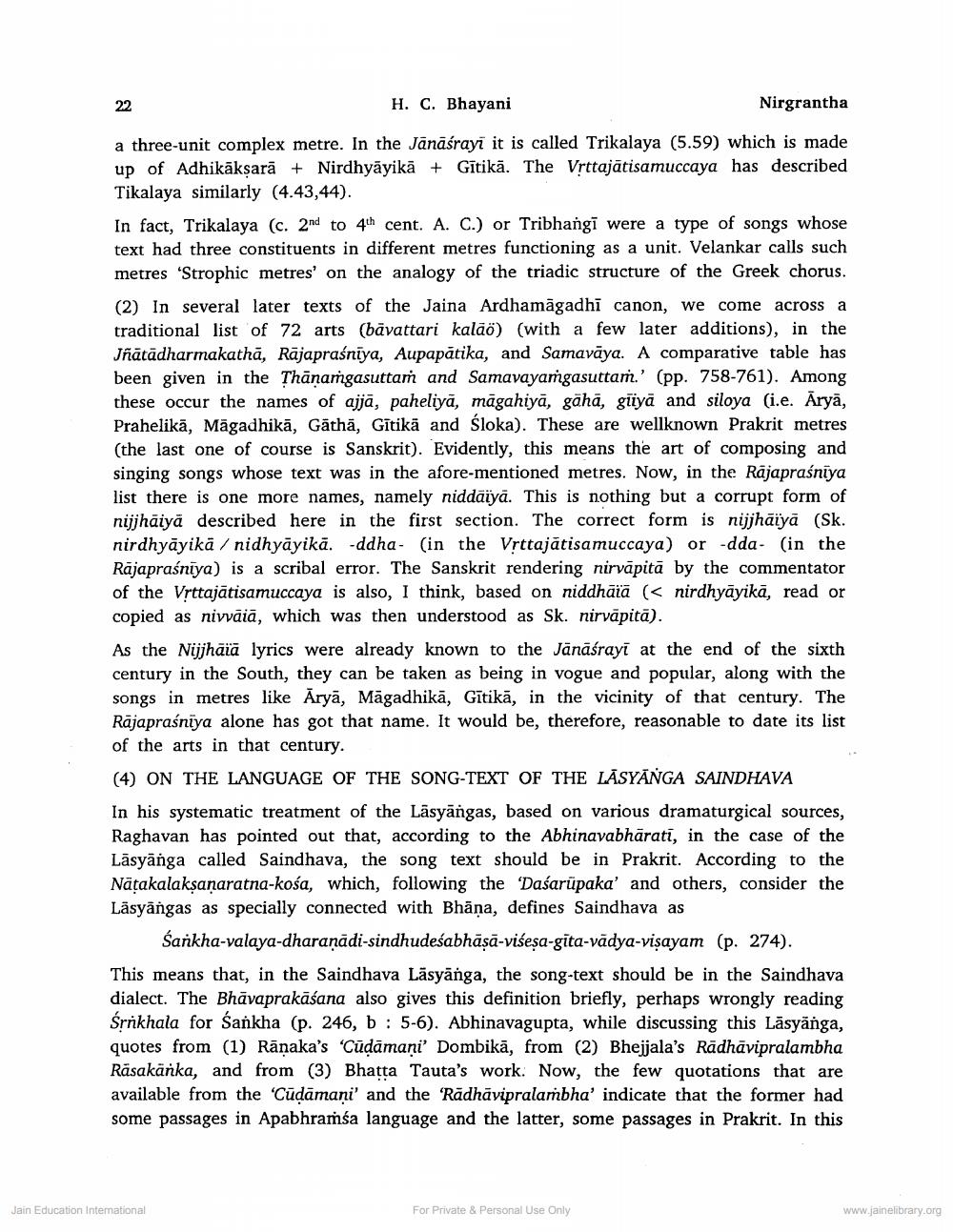________________
H. C. Bhayani
Nirgrantha
a three-unit complex metre. In the Janāśrayi it is called Trikalaya (5.59) which is made up of Adhikākṣarā Nirdhyāyikä + Gitikā. The Vṛttajatisamuccaya has described. Tikalaya similarly (4.43,44).
22
In fact, Trikalaya (c. 2nd to 4th cent. A. C.) or Tribhangi were a type of songs whose text had three constituents in different metres functioning as a unit. Velankar calls such metres 'Strophic metres' on the analogy of the triadic structure of the Greek chorus.
(2) In several later texts of the Jaina Ardhamāgadhi canon, we come across a traditional list of 72 arts (bāvattari kaläö) (with a few later additions), in the Jätädharmakatha, Räjapraśniya, Aupapätika, and Samaväya. A comparative table has been given in the Thanamgasuttaṁ and Samavayamgasuttam.' (pp. 758-761). Among these occur the names of ajjā, paheliyā, māgahiyā, gähä, güyä and siloya (ie. Āryä, Prahelikā, Magadhikā, Gāthā, Gītikā and Śloka). These are wellknown Prakrit metres (the last one of course is Sanskrit). Evidently, this means the art of composing and singing songs whose text was in the afore-mentioned metres. Now, in the Rajapraśniya list there is one more names, namely niddāïyā. This is nothing but a corrupt form of nijjhāiyā described here in the first section. The correct form is nijjhāïyā (Sk. nirdhyāyikā /nidhyāyikā. -ddha- (in the Vṛttajatisamuccaya) or dda (in the Rajapraśniya) is a scribal error. The Sanskrit rendering nirvāpitā by the commentator of the Vṛttajatisamuccaya is also, I think, based on niddhätä (< nirdhyāyikā, read or copied as nivväid, which was then understood as Sk. nirväpitä).
As the Nijjhaïa lyrics were already known to the Jānāśrayī at the end of the sixth century in the South, they can be taken as being in vogue and popular, along with the songs in metres like Āryā, Mägadhikā, Gitikā, in the vicinity of that century. The Rājapraśniya alone has got that name. It would be, therefore, reasonable to date its list of the arts in that century.
(4) ON THE LANGUAGE OF THE SONG-TEXT OF THE LASYANGA SAINDHAVA
In his systematic treatment of the Läsyängas, based on various dramaturgical sources, Raghavan has pointed out that, according to the Abhinavabhārati, in the case of the Läsyänga called Saindhava, the song text should be in Prakrit. According to the Näṭakalakṣaṇaratna-kośa, which, following the Dasarūpaka' and others, consider the Läsyängas as specially connected with Bhāna, defines Saindhava as
Sankha-valaya-dharaṇādi-sindhudeśabhāṣā-viseṣa-gita-vādya-viṣayam (p. 274).
This means that, in the Saindhava Läsyänga, the song-text should be in the Saindhava dialect. The Bhāvaprakāśana also gives this definition briefly, perhaps wrongly reading Śrikhala for Sankha (p. 246, b: 5-6). Abhinavagupta, while discussing this Läsyänga, quotes from (1) Ranaka's Cuḍāmani" Dombikā, from (2) Bhejjala's Radhavipralambha Rasakanka, and from (3) Bhatta Tauta's work. Now, the few quotations that are available from the 'Cüdamani' and the 'Rädhävipralambha' indicate that the former had some passages in Apabhramsa language and the latter, some passages in Prakrit. In this
Jain Education International
For Private & Personal Use Only
www.jainelibrary.org




